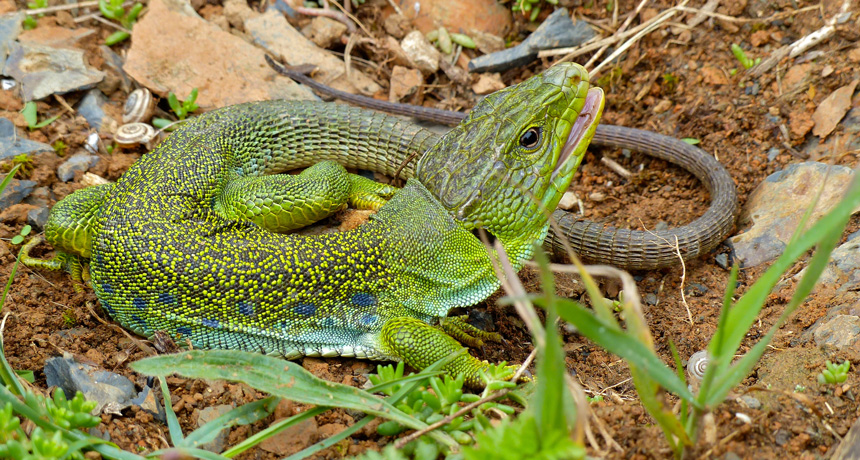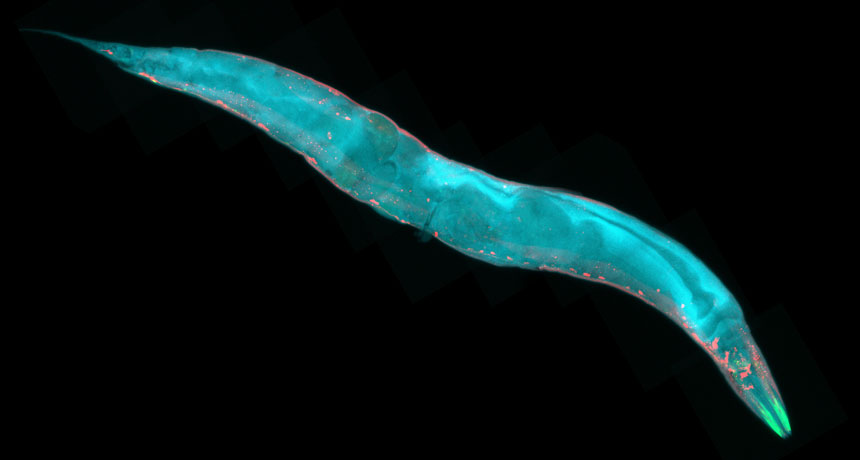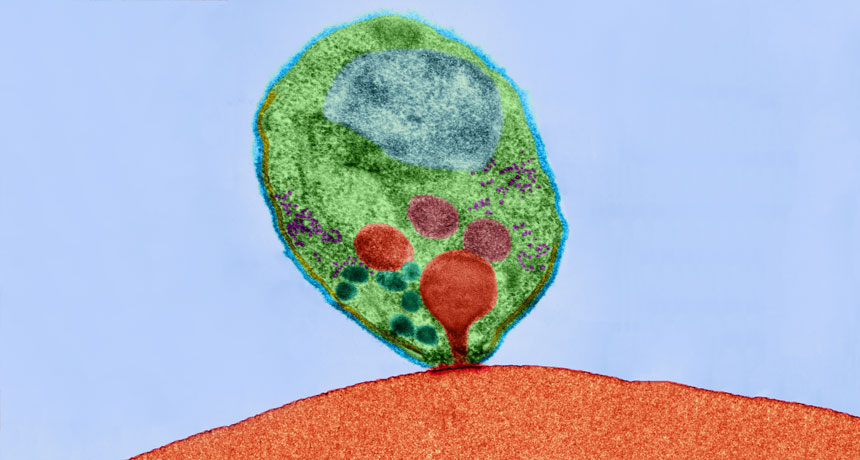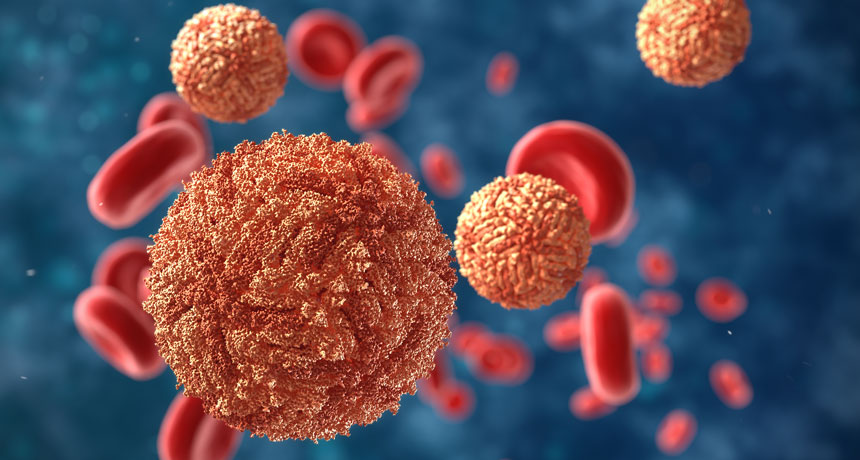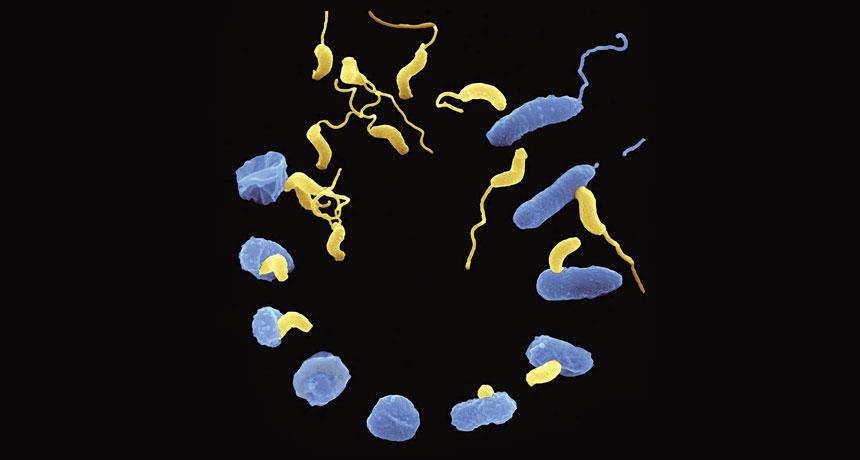There’s still a lot we don’t know about the proton

Nuclear physicist Evangeline Downie hadn’t planned to study one of the thorniest puzzles of the proton.
But when opportunity knocked, Downie couldn’t say no. “It’s the proton,” she exclaims. The mysteries that still swirl around this jewel of the subatomic realm were too tantalizing to resist. The plentiful particles make up much of the visible matter in the universe. “We’re made of them, and we don’t understand them fully,” she says.
Many physicists delving deep into the heart of matter in recent decades have been lured to the more exotic and unfamiliar subatomic particles: mesons, neutrinos and the famous Higgs boson — not the humble proton.
But rather than chasing the rarest of the rare, scientists like Downie are painstakingly scrutinizing the proton itself with ever-higher precision. In the process, some of these proton enthusiasts have stumbled upon problems in areas of physics that scientists thought they had figured out.
Surprisingly, some of the particle’s most basic characteristics are not fully pinned down. The latest measurements of its radius disagree with one another by a wide margin, for example, a fact that captivated Downie. Likewise, scientists can’t yet explain the source of the proton’s spin, a basic quantum property. And some physicists have a deep but unconfirmed suspicion that the seemingly eternal particles don’t live forever — protons may decay. Such a decay is predicted by theories that unite disparate forces of nature under one grand umbrella. But decay has not yet been witnessed.
Like the base of a pyramid, the physics of the proton serves as a foundation for much of what scientists know about the behavior of matter. To understand the intricacies of the universe, says Downie, of George Washington University in Washington, D.C., “we have to start with, in a sense, the simplest system.”
Sizing things up
For most of the universe’s history, protons have been VIPs — very important particles. They formed just millionths of a second after the Big Bang, once the cosmos cooled enough for the positively charged particles to take shape. But protons didn’t step into the spotlight until about 100 years ago, when Ernest Rutherford bombarded nitrogen with radioactively produced particles, breaking up the nuclei and releasing protons.
A single proton in concert with a single electron makes up hydrogen — the most plentiful element in the universe. One or more protons are present in the nucleus of every atom. Each element has a unique number of protons, signified by an element’s atomic number. In the core of the sun, fusing protons generate heat and light needed for life to flourish. Lone protons are also found as cosmic rays, whizzing through space at breakneck speeds, colliding with Earth’s atmosphere and producing showers of other particles, such as electrons, muons and neutrinos.
In short, protons are everywhere. Even minor tweaks to scientists’ understanding of the minuscule particle, therefore, could have far-reaching implications. So any nagging questions, however small in scale, can get proton researchers riled up.
A disagreement of a few percent in measurements of the proton’s radius has attracted intense interest, for example. Until several years ago, scientists agreed: The proton’s radius was about 0.88 femtometers, or 0.88 millionths of a billionth of a meter — about a trillionth the width of a poppy seed.
But that neat picture was upended in the span of a few hours, in May 2010, at the Precision Physics of Simple Atomic Systems conference in Les Houches, France. Two teams of scientists presented new, more precise measurements, unveiling what they thought would be the definitive size of the proton. Instead the figures disagreed by about 4 percent (SN: 7/31/10, p. 7). “We both expected that we would get the same number, so we were both surprised,” says physicist Jan Bernauer of MIT.
By itself, a slight revision of the proton’s radius wouldn’t upend physics. But despite extensive efforts, the groups can’t explain why they get different numbers. As researchers have eliminated simple explanations for the impasse, they’ve begun wondering if the mismatch could be the first hint of a breakdown that could shatter accepted tenets of physics.
The two groups each used different methods to size up the proton. In an experiment at the MAMI particle accelerator in Mainz, Germany, Bernauer and colleagues estimated the proton’s girth by measuring how much electrons’ trajectories were deflected when fired at protons. That test found the expected radius of about 0.88 femtometers (SN Online: 12/17/10).
But a team led by physicist Randolf Pohl of the Max Planck Institute of Quantum Optics in Garching, Germany, used a new, more precise method. The researchers created muonic hydrogen, a proton that is accompanied not by an electron but by a heftier cousin — a muon.
In an experiment at the Paul Scherrer Institute in Villigen, Switzerland, Pohl and collaborators used lasers to bump the muons to higher energy levels. The amount of energy required depends on the size of the proton. Because the more massive muon hugs closer to the proton than electrons do, the energy levels of muonic hydrogen are more sensitive to the proton’s size than ordinary hydrogen, allowing for measurements 10 times as precise as electron-scattering measurements.
Pohl’s results suggested a smaller proton radius, about 0.841 femtometers, a stark difference from the other measurement. Follow-up measurements of muonic deuterium — which has a proton and a neutron in its nucleus — also revealed a smaller than expected size, he and collaborators reported last year in Science. Physicists have racked their brains to explain why the two measurements don’t agree. Experimental error could be to blame, but no one can pinpoint its source. And the theoretical physics used to calculate the radius from the experimental data seems solid.
Now, more outlandish possibilities are being tossed around. An unexpected new particle that interacts with muons but not electrons could explain the difference (SN: 2/23/13, p. 8). That would be revolutionary: Physicists believe that electrons and muons should behave identically in particle interactions. “It’s a very sacred principle in theoretical physics,” says John Negele, a theoretical particle physicist at MIT. “If there’s unambiguous evidence that it’s been broken, that’s really a fundamental discovery.”
But established physics theories die hard. Shaking the foundations of physics, Pohl says, is “what I dream of, but I think that’s not going to happen.” Instead, he suspects, the discrepancy is more likely to be explained through minor tweaks to the experiments or the theory.
The alluring mystery of the proton radius reeled Downie in. During conversations in the lab with some fellow physicists, she learned of an upcoming experiment that could help settle the issue. The experiment’s founders were looking for collaborators, and Downie leaped on the bandwagon. The Muon Proton Scattering Experiment, or MUSE, to take place at the Paul Scherrer Institute beginning in 2018, will scatter both electrons and muons off of protons and compare the results. It offers a way to test whether the two particles behave differently, says Downie, who is now a spokesperson for MUSE.
A host of other experiments are in progress or planning stages. Scientists with the Proton Radius Experiment, or PRad, located at Jefferson Lab in Newport News, Va., hope to improve on Bernauer and colleagues’ electron-scattering measurements. PRad researchers are analyzing their data and should have a new number for the proton radius soon.
But for now, the proton’s identity crisis, at least regarding its size, remains. That poses problems for ultrasensitive tests of one of physicists’ most essential theories. Quantum electrodynamics, or QED, the theory that unites quantum mechanics and Albert Einstein’s special theory of relativity, describes the physics of electromagnetism on small scales. Using this theory, scientists can calculate the properties of quantum systems, such as hydrogen atoms, in exquisite detail — and so far the predictions match reality. But such calculations require some input — including the proton’s radius. Therefore, to subject the theory to even more stringent tests, gauging the proton’s size is a must-do task.
Spin doctors
Even if scientists eventually sort out the proton’s size snags, there’s much left to understand. Dig deep into the proton’s guts, and the seemingly simple particle becomes a kaleidoscope of complexity. Rattling around inside each proton is a trio of particles called quarks: one negatively charged “down” quark and two positively charged “up” quarks. Neutrons, on the flip side, comprise two down quarks and one up quark.
Yet even the quark-trio picture is too simplistic. In addition to the three quarks that are always present, a chaotic swarm of transient particles churns within the proton. Evanescent throngs of additional quarks and their antimatter partners, antiquarks, continually swirl into existence, then annihilate each other. Gluons, the particle “glue” that holds the proton together, careen between particles. Gluons are the messengers of the strong nuclear force, an interaction that causes quarks to fervently attract one another.
As a result of this chaos, the properties of protons — and neutrons as well — are difficult to get a handle on. One property, spin, has taken decades of careful investigation, and it’s still not sorted out. Quantum particles almost seem to be whirling at blistering speed, like the Earth rotating about its axis. This spin produces angular momentum — a quality of a rotating object that, for example, keeps a top revolving until friction slows it. The spin also makes protons behave like tiny magnets, because a rotating electric charge produces a magnetic field. This property is the key to the medical imaging procedure called magnetic resonance imaging, or MRI.
But, like nearly everything quantum, there’s some weirdness mixed in: There’s no actual spinning going on. Because fundamental particles like quarks don’t have a finite physical size — as far as scientists know — they can’t twirl. Despite the lack of spinning, the particles still behave like they have a spin, which can take on only certain values: integer multiples of 1/2.
Quarks have a spin of 1/2, and gluons a spin of 1. These spins combine to help yield the proton’s total spin. In addition, just as the Earth is both spinning about its own axis and orbiting the sun, quarks and gluons may also circle about the proton’s center, producing additional angular momentum that can contribute to the proton’s total spin.
Somehow, the spin and orbital motion of quarks and gluons within the proton combine to produce its spin of 1/2. Originally, physicists expected that the explanation would be simple. The only particles that mattered, they thought, were the proton’s three main quarks, each with a spin of 1/2. If two of those spins were oriented in opposite directions, they could cancel one another out to produce a total spin of 1/2. But experiments beginning in the 1980s showed that “this picture was very far from true,” says theoretical high-energy physicist Juan Rojo of Vrije University Amsterdam. Surprisingly, only a small fraction of the spin seemed to be coming from the quarks, befuddling scientists with what became known as the “spin crisis” (SN: 9/6/97, p. 158). Neutron spin was likewise enigmatic.
Scientists’ next hunch was that gluons contribute to the proton’s spin. “Verifying this hypothesis was very difficult,” Rojo says. It required experimental studies at the Relativistic Heavy Ion Collider, RHIC, a particle accelerator at Brookhaven National Laboratory in Upton, N.Y.
In these experiments, scientists collided protons that were polarized: The two protons’ spins were either aligned or pointed in opposite directions. Researchers counted the products of those collisions and compared the results for aligned and opposing spins. The results revealed how much of the spin comes from gluons. According to an analysis by Rojo and colleagues, published in Nuclear Physics B in 2014, gluons make up about 35 percent of the proton’s spin. Since the quarks make up about 25 percent, that leaves another 40 percent still unaccounted for.
“We have absolutely no idea how the entire spin is made up,” says nuclear physicist Elke-Caroline Aschenauer of Brookhaven. “We maybe have understood a small fraction of it.” That’s because each quark or gluon carries a certain fraction of the proton’s energy, and the lowest energy quarks and gluons cannot be spotted at RHIC. A proposed collider, called the Electron-Ion Collider (location to be determined), could help scientists investigate the neglected territory.
The Electron-Ion Collider could also allow scientists to map the still-unmeasured orbital motion of quarks and gluons, which may contribute to the proton’s spin as well.
An unruly force
Experimental physicists get little help from theoretical physics when attempting to unravel the proton’s spin and its other perplexities. “The proton is not something you can calculate from first principles,” Aschenauer says. Quantum chromo-dynamics, or QCD — the theory of the quark-corralling strong force transmitted by gluons — is an unruly beast. It is so complex that scientists can’t directly solve the theory’s equations.
The difficulty lies with the behavior of the strong force. As long as quarks and their companions stick relatively close, they are happy and can mill about the proton at will. But absence makes the heart grow fonder: The farther apart the quarks get, the more insistently the strong force pulls them back together, containing them within the proton. This behavior explains why no one has found a single quark in isolation. It also makes the proton’s properties especially difficult to calculate. Without accurate theoretical calculations, scientists can’t predict what the proton’s radius should be, or how the spin should be divvied up.
To simplify the math of the proton, physicists use a technique called lattice QCD, in which they imagine that the world is made of a grid of points in space and time (SN: 8/7/04, p. 90). A quark can sit at one point or another in the grid, but not in the spaces in between. Time, likewise, proceeds in jumps. In such a situation, QCD becomes more manageable, though calculations still require powerful supercomputers.
Lattice QCD calculations of the proton’s spin are making progress, but there’s still plenty of uncertainty. In 2015, theoretical particle and nuclear physicist Keh-Fei Liu and colleagues calculated the spin contributions from the gluons, the quarks and the quarks’ angular momentum, reporting the results in Physical Review D. By their calculation, about half of the spin comes from the quarks’ motion within the proton, about a quarter from the quarks’ spin, with the last quarter or so from the gluons. The numbers don’t exactly match the experimental measurements, but that’s understandable — the lattice QCD numbers are still fuzzy. The calculation relies on various approximations, so it “is not cast in stone,” says Liu, of the University of Kentucky in Lexington.
Death of a proton
Although protons seem to live forever, scientists have long questioned that immortality. Some popular theories predict that protons decay, disintegrating into other particles over long timescales. Yet despite extensive searches, no hint of this demise has materialized.
A class of ideas known as grand unified theories predict that protons eventually succumb. These theories unite three of the forces of nature, creating a single framework that could explain electromagnetism, the strong nuclear force and the weak nuclear force, which is responsible for certain types of radioactive decay. (Nature’s fourth force, gravity, is not yet incorporated into these models.) Under such unified theories, the three forces reach equal strengths at extremely high energies. Such energetic conditions were present in the early universe — well before protons formed — just a trillionth of a trillionth of a trillionth of a second after the Big Bang. As the cosmos cooled, those forces would have separated into three different facets that scientists now observe.
“We have a lot of circumstantial evidence that something like unification must be happening,” says theoretical high-energy physicist Kaladi Babu of Oklahoma State University in Stillwater. Beyond the appeal of uniting the forces, grand unified theories could explain some curious coincidences of physics, such as the fact that the proton’s electric charge precisely balances the electron’s charge. Another bonus is that the particles in grand unified theories fill out a family tree, with quarks becoming the kin of electrons, for example.
Under these theories, a decaying proton would disintegrate into other particles, such as a positron (the antimatter version of an electron) and a particle called a pion, composed of a quark and an antiquark, which itself eventually decays. If such a grand unified theory is correct and protons do decay, the process must be extremely rare — protons must live a very long time, on average, before they break down. If most protons decayed rapidly, atoms wouldn’t stick around long either, and the matter that makes up stars, planets — even human bodies — would be falling apart left and right.
Protons have existed for 13.8 billion years, since just after the Big Bang. So they must live exceedingly long lives, on average. But the particles could perish at even longer timescales. If they do, scientists should be able to monitor many particles at once to see a few protons bite the dust ahead of the curve (SN: 12/15/79, p. 405). But searches for decaying protons have so far come up empty.
Still, the search continues. To hunt for decaying protons, scientists go deep underground, for example, to a mine in Hida, Japan. There, at the Super-Kamiokande experiment (SN: 2/18/17, p. 24), they monitor a giant tank of water — 50,000 metric tons’ worth — waiting for a single proton to wink out of existence. After watching that water tank for nearly two decades, the scientists reported in the Jan. 1 Physical Review D that protons must live longer than 1.6 × 1034 years on average, assuming they decay predominantly into a positron and a pion.
Experimental limits on the proton lifetime “are sort of painting the theorists into a corner,” says Ed Kearns of Boston University, who searches for proton decay with Super-K. If a new theory predicts a proton lifetime shorter than what Super-K has measured, it’s wrong. Physicists must go back to the drawing board until they come up with a theory that agrees with Super-K’s proton-decay drought.
Many grand unified theories that remain standing in the wake of Super-K’s measurements incorporate supersymmetry, the idea that each known particle has another, more massive partner. In such theories, those new particles are additional pieces in the puzzle, fitting into an even larger family tree of interconnected particles. But theories that rely on supersymmetry may be in trouble. “We would have preferred to see supersymmetry at the Large Hadron Collider by now,” Babu says, referring to the particle accelerator located at the European particle physics lab, CERN, in Geneva, which has consistently come up empty in supersymmetry searches since it turned on in 2009 (SN: 10/1/16, p. 12).
But supersymmetric particles could simply be too massive for the LHC to find. And some grand unified theories that don’t require supersymmetry still remain viable. Versions of these theories predict proton lifetimes within reach of an upcoming generation of experiments. Scientists plan to follow up Super-K with Hyper-K, with an even bigger tank of water. And DUNE, the Deep Underground Neutrino Experiment, planned for installation in a former gold mine in Lead, S.D., will use liquid argon to detect protons decaying into particles that the water detectors might miss.
If protons do decay, the universe will become frail in its old age. According to Super-K, sometime well after its 1034 birthday, the cosmos will become a barren sea of light. Stars, planets and life will disappear. If seemingly dependable protons give in, it could spell the death of the universe as we know it.
Although protons may eventually become extinct, proton research isn’t going out of style anytime soon. Even if scientists resolve the dilemmas of radius, spin and lifetime, more questions will pile up — it’s part of the labyrinthine task of studying quantum particles that multiply in complexity the closer scientists look. These deeper studies are worthwhile, says Downie. The inscrutable proton is “the most fundamental building block of everything, and until we understand that, we can’t say we understand anything else.”

